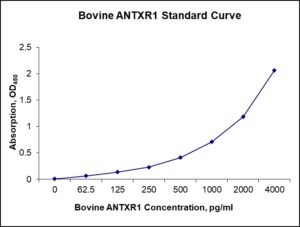Nori Bovine ANTXR1 ELISA Kit
$461.00 – $832.00
This ELISA kit is for quantification of ANTXR1 in bovine. This is a quick ELISA assay that reduces time to 50% compared to the conventional method, and the entire assay only takes 3 hours. This assay employs the quantitative sandwich enzyme immunoassay technique and uses biotin-streptavidin chemistry to improve the performance of the assays. An antibody specific for ANTXR1 has been pre-coated onto a microplate. Standards and samples are pipetted into the wells and any ANTXR1 present is bound by the immobilized antibody. After washing away any unbound substances, a detection antibody specific for ANTXR1 is added to the wells. Following wash to remove any unbound antibody reagent, a detection reagent is added. After intensive wash a substrate solution is added to the wells and color develops in proportion to the amount of ANTXR1 bound in the initial step. The color development is stopped, and the intensity of the color is measured.
Alternative names for ANTXR1: Anthrax receptor 1
This product is for Laboratory Research Use Only, not for diagnostic and therapeutic purposes or any other purposes.
- Description
- How Elisa Works
- Product Citation (0)
- Reviews (0)
Description
Nori Bovine ANTXR1 ELISA Kit Summary
Alternative names for ANTXR1: Anthrax receptor 1
Alternative names for bovine: Cattle, cow, bull
| Assay Type | Solid Phase Sandwich ELISA |
| Format | 96-well Microplate or 96-Well Strip Microplate |
| Method of Detection | Colorimetric |
| Number of Targets Detected | 1 |
| Target Antigen Accession Number | A0A3Q1MVZ0 |
| Assay Length | 3 hours |
| Quantitative/Semiquantitative | Quantitative |
| Sample Type | Plasma, Serum, Cell Culture, Urine, Cell/Tissue Lysates, Synovial Fluid, BAL, |
| Recommended Sample Dilution (Plasma/Serum) | No dilution for sample <ULOQ; sufficient dilution for samples >ULOQ |
| Sensitivity | 5 pg/mL |
| Detection Range | 62.5-4000 Pg/mL |
| Specificity | Bovine ANTXR1 |
| Cross-Reactivity | < 0.5% cross-reactivity observed with available related molecules, < 50% cross-species reactivity observed with species tested. |
| Interference | No significant interference observed with available related molecules |
| Storage/Stability | 4 ºC for up to 6 months |
| Usage | For Laboratory Research Use Only. Not for diagnostic or therapeutic use. |
| Additional Notes | The kit allows for use in multiple experiments. |
Standard Curve
Kit Components
1. Pre-coated 96-well Microplate
2. Biotinylated Detection Antibody
3. Streptavidin-HRP Conjugate
4. Lyophilized Standards
5. TMB One-Step Substrate
6. Stop Solution
7. 20 x PBS
8. Assay Buffer
Other Materials Required but not Provided:
1. Microplate Reader capable of measuring absorption at 450 nm
2. Log-log graph paper or computer and software for ELISA data analysis
3. Precision pipettes (1-1000 µl)
4. Multi-channel pipettes (300 µl)
5. Distilled or deionized water
Protocol Outline
1. Prepare all reagents, samples and standards as instructed in the datasheet.
2. Add 100 µl of Standard or samples to each well and incubate 1 h at RT.
3. Add 100 µl of Working Detection Antibody to each well and incubate 1 h at RT.
4. Add 100 µl of Working Streptavidin-HRP to each well and incubate 20 min at RT.
5. Add 100 µl of Substrate to each well and incubate 5-30 min at RT.
6. Add 50 µl of Stop Solution to each well and read at 450 nm immediately.
Background:
Anthrax toxin is a key virulence factor for Bacillus anthracis, the causative agent of anthrax. The anthrax toxin receptor (ATR) is the cellular receptor for anthrax toxin. ATR was identified as a type I transmembrane protein with unknown function that contains an extracellular integrin-like inserted (I) domain. The ATR I domain contains the toxin binding site, and a soluble form of this domain was shown to serve as an effective antitoxin to protect cultured cells from toxin action. ATR1 is encoded by the tumor endothelial marker 8 (TEM8) gene, which is selectively up-regulated during blood vessel formation and in tumor vasculature, raising the possibility that this protein normally functions in angiogenesis. Therefore, identification of the cellular receptor for anthrax toxin has made possible new avenues of research in the areas of anthrax pathogenesis, antitoxin development, and cancer biology. Anthrax toxin receptor 1 (ANTXR1) is a protein that is encoded by the ANTXR1 gene.[1][2] The protein encoded by this gene is a type I transmembrane protein and is a tumor-specific endothelial marker that has been implicated in colorectal cancer. This protein has been shown to also be a docking protein or receptor for Bacillus anthracis toxin, the causative agent of the disease, anthrax. The binding of the protective antigen (PA) component, of the tripartite anthrax toxin, to this receptor protein mediates delivery of toxin components to the cytosol of cells. Once inside the cell, the other two components of anthrax toxin, edema factor (EF) and lethal factor (LF) disrupt normal cellular processes. Three alternatively spliced variants have been described.
References
- St Croix B, et al. (2000). Science289 (5482): 1197–202.
- Carson-Walter EB, et al. (2001) Cancer Res61 (18): 6649–55.
Be the first to review “Nori Bovine ANTXR1 ELISA Kit”
You must be logged in to post a review.




























Reviews
There are no reviews yet.